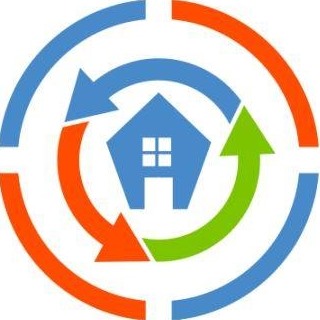- Page Index
- What is Lead Poisoning?
- When should children in Milwaukee and Racine be tested for lead poisoning?
- Where is Lead Found?
- How are children poisoned by lead in PAINT and what can parents do about it?
- How are children poisoned by lead in WATER and what can parents do about it?
- How are children poisoned by lead in SOIL and what can parents do about it?
- Where have lead hazards been found in Milwaukee by district?
- Which addresses in Milwaukee have been abated? Which addresses are currently undergoing lead abatement?
- What are examples of lead-removing filters for your home?
- What materials does COLE use to educate parents and outreach workers?
- Information for Healthcare Providers
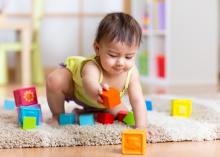
What is Lead Poisoning?
Children become lead poisoned when they eat, drink, or breathe in lead. Usually there are no symptoms, but even small amounts of lead can affect a child’s ability to learn, pay attention in school, and get along with others. Therefore, low levels of lead exposure can diminish your child’s opportunities throughout life – the very quality of his or her life.
In addition, high levels of lead poisoning can cause physical ailments such as seizures, kidney damage, and even death.
You will most likely not see symptoms in your lead-poisoned child under 3 years of age. Nonetheless, irreversible brain damage can already have occurred. Therefore, it is especially important that children are tested early and often (See the next section.)
Learn more about how lead poisoning affects children:

When should children in Milwaukee and Racine be tested for lead poisoning?
In some older neighborhoods of Milwaukee, at least 3 out of every 10 children tested are found to be lead poisoned. By law in Milwaukee and Racine, ALL children must be tested three times before the age of three – at 12 months, 18 months, and 24 months.
Children ages 3 through 5 should be tested each year if they meet one or more of the following criteria. Please note that all children enrolled in Medicaid, SNAP and WIC meet this criterion and should be tested as well at ages 3, 4 and 5.
- They live in a house built before 1950.
- They live in a house built before 1978 that’s recently undergone or currently undergoing renovations.
- They have a sibling or playmate with lead poisoning.
- They are enrolled in Medicaid or WIC (Special Supplemental Nutrition Program for Women, Infants, and Children), or are uninsured.
- They have no record of a prior test.
Learn more about when to test your children:
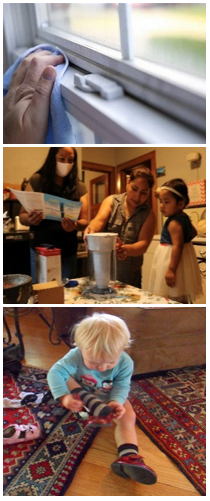
Where is Lead Found?
Children most often become lead poisoned from:
- PAINT inside old houses that were built before 1978
- WATER delivered by pipes made of lead or plumbing that contains lead. Scroll down to “What are examples of lead-removing filters for your home?” for lead-approved filters.
- SOIL contaminated by old paint that has peeled off the house. Soil might have been lead contaminated from leaded gas or other sources.
But children can also become lead poisoned from some toys and jewelry from other countries, some pottery, spices and foods from other countries, and from lead brought in from their parent’s workplace.
Learn more about sources of lead:

How are children poisoned by lead in PAINT and what can parents do about it?
Paint containing lead is the most common way children are poisoned. This paint is found inside and out on houses built before 1978. It creates a problem when it chips to create flakes and dust.
As a temporary measure, one can duct-tape over problem areas until the area can be fixed. Anytime the paint is scraped, lead dust can be generated; for example, in windowsills and on lead-painted floors and furniture. Wet-wiping windowsills and hard surfaces is needed to keep the dust in check.
Unfortunately, paint tastes very sweet to children. This is very bad for toddlers, who like to put things in their mouths. This dust can settle on the floor where children crawl and on their toys. Therefore, it is important to keep the floors and toys washed and that children wash their hands often, especially before eating.
For Paint – DO!
- Wash hands often, especially before eating!
- Wash toys frequently.
- Wet-wipe floors, windowsills, and other hard surfaces.
- Tape over flaking paint.
- If you vacuum, use a HEPA filter.
- Use a professional for abatement.
- Rent a home which is lead-free or where the lead has been abated.
For Paint – DON’T!
- Don’t let kids play on a dusty floor.
- Don’t let kids play around windowsills.
- Don’t let kids eat paint chips.
- Don’t let kids eat without washing hands.
- Don’t dry sweep or vacuum surfaces. (Wet-wipe instead.)
- Don’t scrape or sand lead painted surfaces.
Learn more about how to protect your children from lead in paint:
- From the Wisconsin DHS’s “Lead-Safe Wisconsin: Where is Lead Commonly Found in Wisconsin?” Scroll down to sections “paint” and “air”.
- From COLE, MHD, SDC, and Sixteenth St. CHC “How to Clean Lead Dust from Hard Surface Floors”
- From COLE, MHD, SDC, and Sixteenth St. CHC “How to Clean Your Windows in a Lead-Safe Way”
- From the MKE Nutrition and Lead Task Force “At Risk for Lead in Paint?“
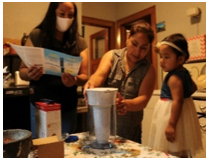
How are children poisoned by lead in WATER and what can parents do about it?
A house built before 1986 in Milwaukee will initially have a lead service line connecting it to the city’s water. It can also have lead in plumbing, fixtures and faucets. This contaminates the water you drink.
The only way to avoid lead is to use a water filter certified for Lead with an “NSF/ANSI Standard 53” rating. It is good to flush your pipes for 3-5 minutes as well. It is especially important to use a filter for making baby formula, for drinking and cooking. Usually, it is best for women to breast-feed their infants to avoid lead, but nursing mothers should also be tested for lead.
Infants can become poisoned from baby formula made with water that contains lead. When making formula, parents should use a lead-certified water filter. Parents should never use hot water for making formula or cooking. Hot water can cause more lead to dissolve in the water and boiling will concentrate whatever lead is there. So only use COLD water.
For Water – DO!
- Get and use a lead-certified water filter.
- Flush your pipes before adding water to the filter.
- Change filter cartridges as directed.
- Use COLD filtered water for drinking and cooking.
- Use COLD filtered water making baby formula.
- Check to see if you have a lead service line.
For Water – DON’T!
- Do not use unfiltered water for drinking, cooking, or making baby formula.
- Do not use hot water to cook.
- Do not use hot water for baby formula.
Learn more about how to protect your children from lead in water:
- From the Wisconsin DHS’s “Lead-Safe Wisconsin: Where is Lead Commonly Found in Wisconsin?” Scroll down to “water” section.
- From the MKE Nutrition and Lead Task Force “At Risk for Lead in Water?
- From Milwaukee Health Department’s Do I need a water filter?
- To find out if your home has a lead service line, you can look up your address on the Milwaukee Water Works list or by calling Milwaukee Water Works customer service at (414) 286-2830.
- Do I Need A Filter?

How are children poisoned by lead in SOIL and what can parents do about it?
Soil can become contaminated with leaded paint that has peeled off a house built before 1978. Bare dirt next to the house or near a lead-painted fence can become very contaminated. But paint dust can spread to other areas in the yard as well. Because leaded gas was used for cars prior to 1975, soil within a half mile of an expressway can also be contaminated. Therefore it is important that children not play in bare dirt in the yard. To remedy this, cover bare dirt outside with grass or mulch.
Similarly, soil can become contaminated from proximity to a small airport up to one and a half miles away, because small aircraft continue to use leaded fuel. Soil can also become contaminated with lead from unknown sources such as having been the site of a battery factory.
Family members should remove their shoes at the door. Children should not play in bare dirt and should wash their hands when coming in from playing outside. Wash off toys and garden tools outside. If you have a garden, build up the soil with clean soil and wash ALL fruits and vegetables from your garden and from the store. Wash pets’ paws before entering the house as well.
For Soil – DO!
- Remove shoes at the door!
- Wash hands after playing outside.
- Children should not play in bare dirt in the yard.
- Cover bare dirt with grass or mulch.
- Add clean soil to a garden.
- Wash all fruits and vegetables that come into the house.
For Soil – DON’T!
- Do not let children play in bare dirt.
- Do not walk in the house with shoes or clothes exposed to bare dirt.
Learn more about how to protect your child from lead in soil:
- From the MKE Nutrition and Lead Task Force “At Risk for Lead in Soil”?
- From the Wisconsin DHS’s “Lead-Safe Wisconsin: Where is Lead Commonly Found in Wisconsin?” Scroll down to section “soil.”
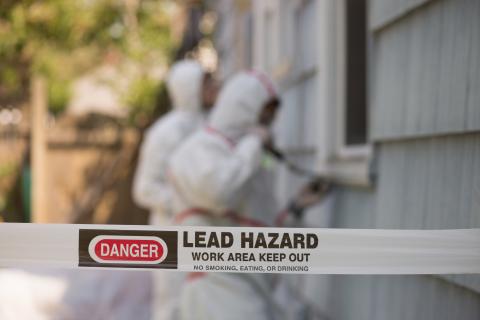
How are children poisoned by lead from OTHER SOURCES and what can parents do about it?
Parents can bring in lead from their workplace or after working with a lead battery, firearms, lead fishing gear, or other hobby that includes lead. Therefore, it is important that parents remove contaminated clothing and wash hands upon entering the home or after handling such items.
Because lead softens plastic and makes it more flexible, it is often found in children’s toys and jewelry, especially cheaply made, imported toys. Lead also may be found in the paint on toys—those made in the United States before 1978 and those made in other countries.
In addition, lead can be found in certain foods, traditional medicines, cosmetics and candies imported from other countries. The resources below describe these sources of lead and can help you avoid them. Lead can also be found in old aluminum cookware and in some ceramic glazes. Use the resources below to understand more about other sources of lead.
For other sources – DO!
- Wash hands if coming from a contaminated workplace.
- Remove contaminated shoes and clothing before entering the house.
- Check the searchable database below to learn about toys and other children’s products with lead.
- Check the lists of foods, cosmetics, medicines and cookware below that contain lead.
- Purchase toys, cookware, food and spices that come from the U.S.
For other sources – DON’T!
- Do not bring contaminated shoes and clothing into the home.
- Do not purchase inexpensive toys made outside of the U.S.
- Beware of jewelry which may be a source of lead.
- Do not purchase food and spices noted as potentially containing lead.
- Do not use old aluminum pans or ceramic-covered cookware that may contain lead.
Learn more about how to protect your child from other sources of lead:
- From the Wisconsin DHS “Lead Safe Wisconsin: Other Sources of Lead” Then select the headings: “Consumer products for children,” “Food items, cosmetics and medicines,” “Hobbies and work” and “Other Products” to learn about specific items.
- From the Wisconsin DHS “Lead Safe Wisconsin: Occupational Lead
- A searchable database of toys and other children’s products found to contain unsafe levels of lead from the U.S. Consumer Product Safety Commission
- From the Center for Disease Control (CDC)’s “Lead in jobs, hobbies or other activities”
- https://www.surveygizmo.com/s3/3644687/File-a-Complaint-about-Unsafe-Lead-or-Asbestos-Work to report unsafe lead or asbestos at work
Nutrition and Lead
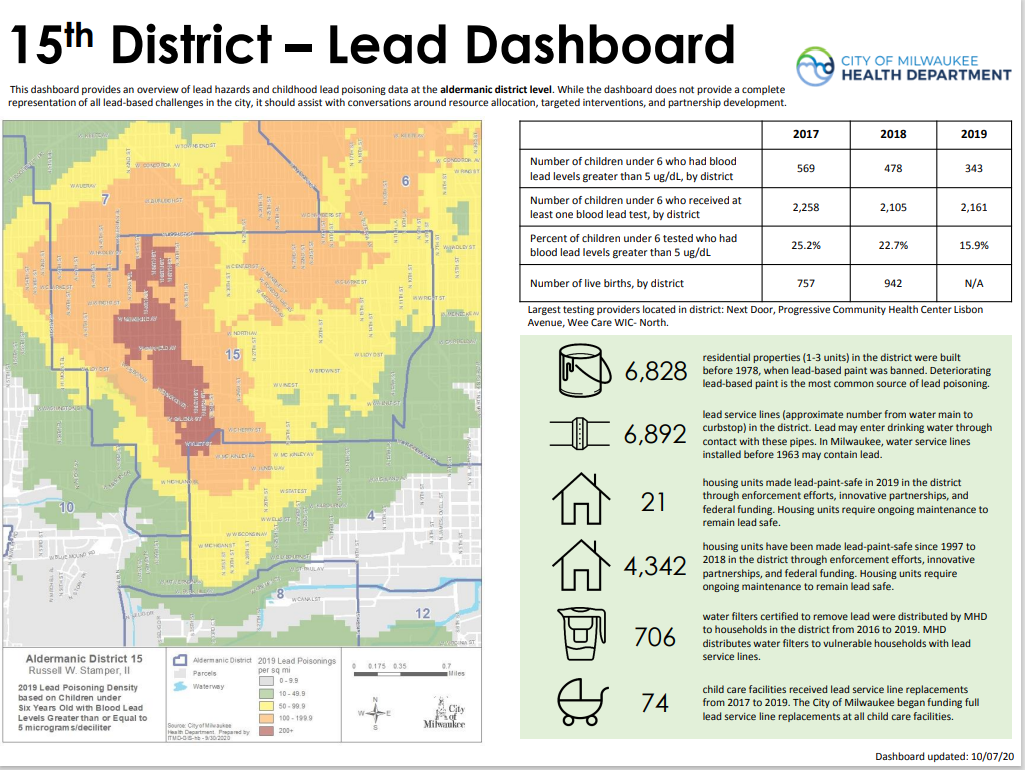
Where have lead hazards been found in Milwaukee by district?
This “Lead Dashboard” provides information about childhood lead poisoning in Milwaukee, as reported for each aldermanic district.
However, it uses the old criterion of 5 micrograms of lead per deciliter of blood and reports on data from 2017, 2018 and 2019.
The maps, however, refer only to data from 2019. The colors indicate the number of children poisoned per square mile as shown in the key.
(Undoubtedly many more children were actually lead poisoned based on the new criterion of 3.5 micrograms.) But this dashboard is helpful nonetheless in providing a map that shows neighborhoods within each district where lead poisoning is prevalent.
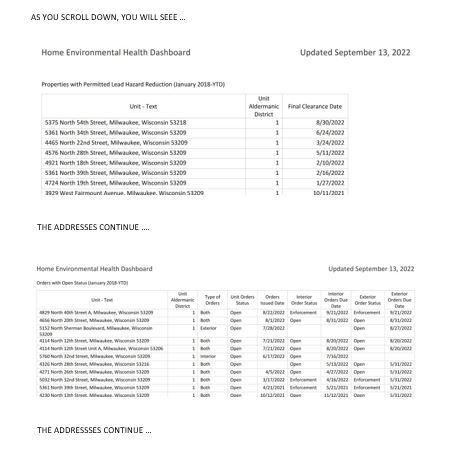
Which addresses in Milwaukee have been abated? Which addresses are currently undergoing lead abatement?
The city regularly posts list of properties that have open and closed orders for abatement. Scroll down to find the heading “Properties with Permitted Lead Hazard Reduction (January 2018-YTD)” to see the list of residences that have completed abatement. Scroll to the heading “Orders with Open Status (January 2018-YTD)” to see the address of properties with lead hazards that have not yet been abated.
- Open the Milwaukee Health Department “Home Environmental Health Division” webpage and select “View HEH Dashboard” to access both lists.
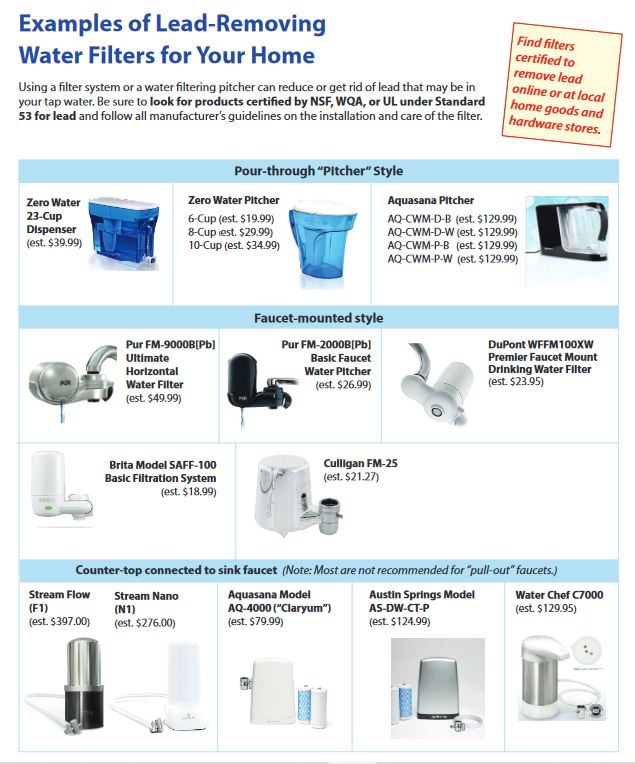
What are examples of lead-removing filters for your home?
Certified lead filters that fit into special pitchers are an immediate solution to purify drinking water. Be sure to run your faucet for 3-5 minutes first.
However, filters that attach to faucets or even home-wide systems can address uses throughout the home. These can better address needs such as cooking, washing dishes, and using an additional faucet for drinking or for brushing teeth. It is important that filters are changed regularly, according to the directions provided.
Make sure that filters are certified by NSF under Standard 53 for lead.
- Open the Milwaukee Health Department “Drinking Water Filter Program” webpage and scroll down to read commonly asked questions about lead-removing filters.
- Open the Milwaukee Health Department “Examples of Lead-Removing Water Filters for Your Home”. (En Español y Ingles) (These include Pour-through “Pitcher” Style, Faucet-mounted style, Filter that attached under the sink, & Counter-top connected to sink faucet)
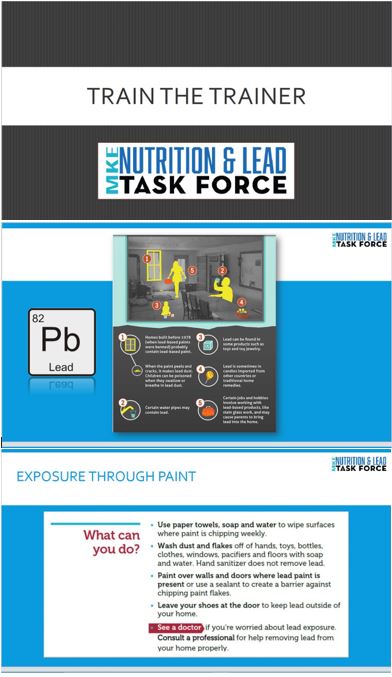
What materials does COLE use to educate parents and outreach workers?
- TRAIN THE TRAINER PowerPoint for parents and outreach workers
- Examples of Lead-Removing Water Filters for Your Home English and Spanish
- Brochures in English
- Brochures in Spanish
- Full Sheets (Paint, Water, Soil, & Nutrition)
- Trifold
- Brochures in Hmong
- Clean Hard Surface Flyer
- Clean Windows Flyer
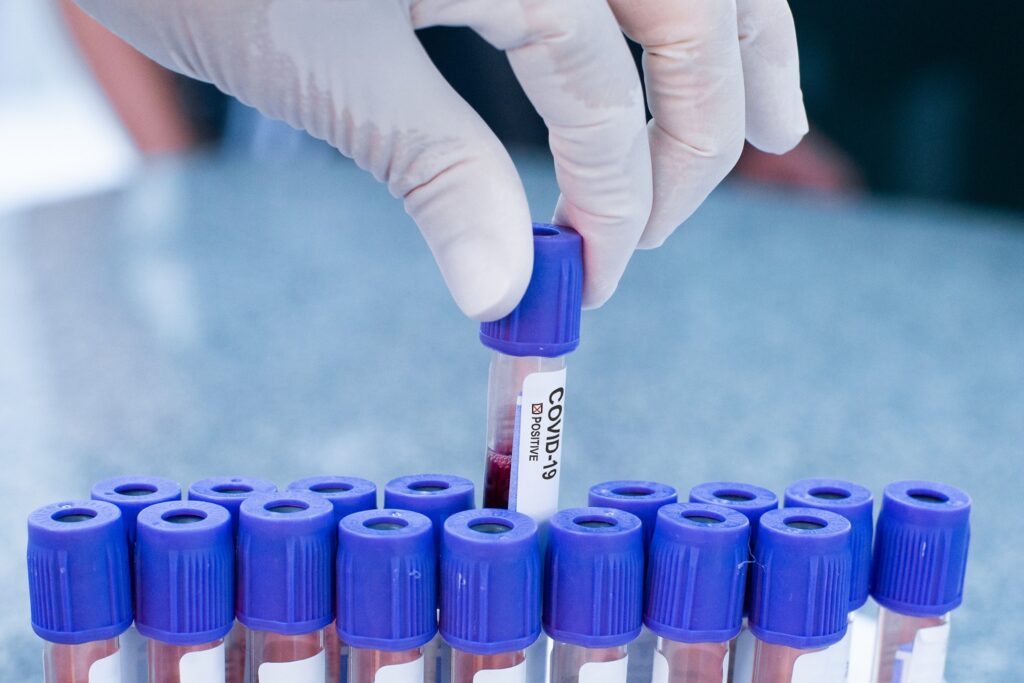
Information for Healthcare Providers
- From Wisconsin DHS, “Lead-Safe Wisconsin: Pediatric Lead Testing and Reporting”
- The following “stellar practices” suggest office workflow tools and a clinic culture that optimize lead testing in children. They are based on interviews with clinicians who have “stellar” records in this regard. They are not intended to be official standards, but rather a guide to increase rates of lead testing for children. (See CDC, WHS, AAP, ACOG links below for professional requirements. References provided.)
